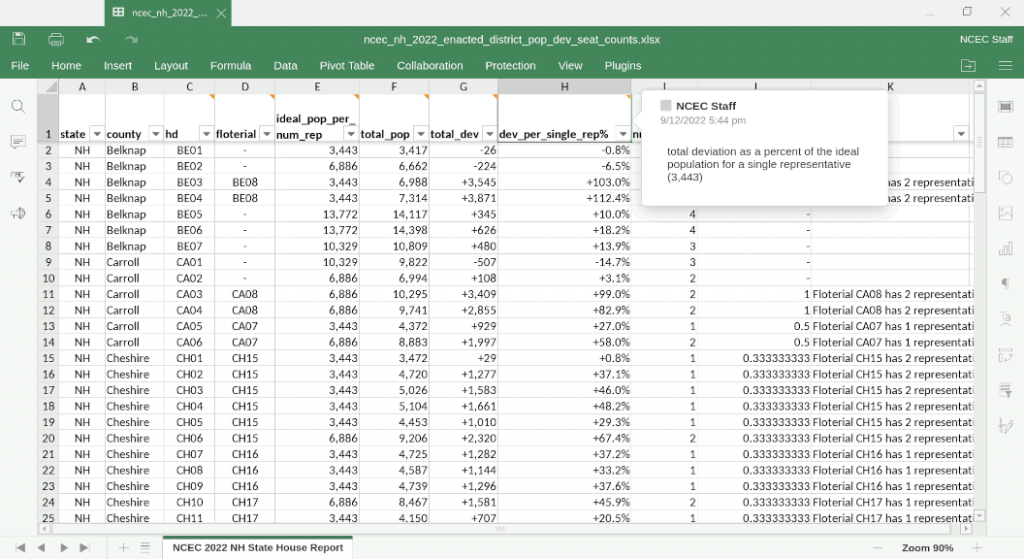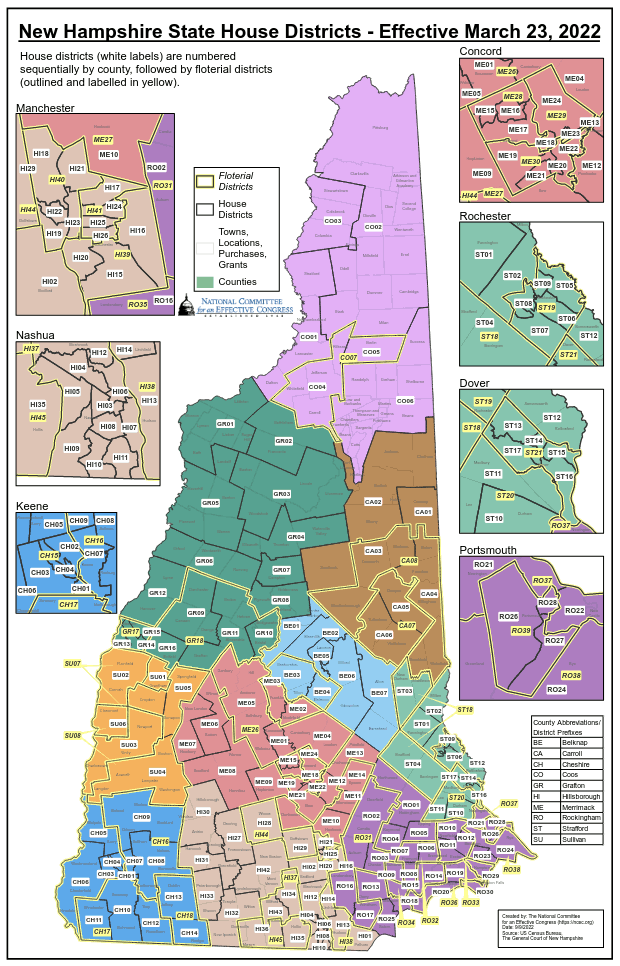Some common reports and data files are not readily available for the New Hampshire House of Representatives 2022 redistricting plan. During and after redistricting, states typically provide updated population counts, population deviations, and maps. But official New Hampshire sources have not been forthcoming with this information for their newly enacted State House districts.
When redistricting began in 2021, New Hampshire Republicans had a government trifecta (control of the governor’s office, the Senate, and the House). Republican control of the process has resulted in a lack of transparency. To remedy this, the NCEC is providing the following resources which we have processed ourselves.
New Hampshire 2022 State House Population Report
ncec_nh_2022_enacted_district_pop_dev_seat_counts.xlsx

In the spreadsheet file linked above, pay special attention to the “dev_per_single_rep%” column. The excess percentage should, ideally, count towards a district’s share of its floterial representation. But the floterial assignments of many districts are not justified by the data alone. We cannot know the mind of the Republican politicians who devised the plan. But it seems clear that some single districts with enough deviation to warrant an additional representative were, instead, included in a floterial district to draw certain incumbents together and force them to compete against members of their own party in primary elections. In other areas, several districts are grouped together in ways that obfuscate partisan gamesmanship.
New Hampshire 2022 Redistricting
On March 23, 2022, New Hampshire Governor Chris Sununu signed HB50, establishing new state house districts for the next decade. It was the beginning of a redistricting process fraught with drama. In May, the New Hampshire Supreme Court approved a new congressional map after the governor vetoed two proposals backed by the Legislature. He rejected both as Republican gerrymanders, claiming they were not fair. Whatever the motive, he also vetoed two bills in 2019 and 2020 that would have established an independent redistricting commission. As he has openly considered higher office—US Senate in 2022 and the presidency in 2024—this looks more like the converse of a popular phrase: Do what’s right only when everyone is looking.
Redistricting Background
In most states, representatives (of the lower chamber) are elected from single-member districts of roughly equal population, based on the “one person, one vote” principle established in Baker v. Carr (1962) and Reynolds v. Sims (1964). Following each census, the new state population and number of districts are used to determine the ideal district population. District boundaries are then adjusted so that each district’s population is close to the ideal population, within some pre-determined range (commonly ±5.0%).
Some states, including Arizona, New Jersey, South Dakota, and Washington, elect members from multi-member districts. These function essentially the same as single-member districts, but the ideal population is determined by the number of representatives rather than the number of districts. New Hampshire has both single- and multi-member districts. However, before redistricting in 2011 the state introduced another method for redistricting, known as floterial districts.
New Hampshire Floterial Districts
Currently, the New Hampshire House of Representatives consists of 400 members. Based on the state’s 2020 Census population of 1,377,529, the ideal house district population is 3,443. The state constitution requires that districts be created from whole geographic units (in this case towns or wards), and each is entitled to at least one representative in a non-floterial district. Any town, ward, or unincorporated place lacking the population to comprise at least one district can be grouped with others if their total aggregate population is close enough to the ideal (or a multiple of the ideal) within a “reasonable deviation.” Areas with enough population to support multiple districts are allocated a matching number of representatives to satisfy the population requirement (also within a “reasonable deviation”). In the newly enacted plan, the most populous district has 10 representatives.
To address potential malapportionment resulting from this configuration, in 2006 the state constitution was amended to allow for floterial districts. Put simply, if there is enough surplus population in a group of districts to populate additional districts, then a “floating” district is created that includes those districts. The newly enacted plan consists of 39 floterial districts represented by 58 members (with up to four members in a single floterial district).
Impact and Conclusion
The 2022 state house plan enacted by New Hampshire Republicans is intended to protect their majority. The plan in effect from 2012 to 2021 contained 75 competitive seats, where Joe Biden received between 47.5 and 52.5 percent of the major-party 2020 vote. The newly enacted plan contains the same number of competitive seats, but the number of Democratic-leaning seats is reduced by 12, from 198 to 186.
Since Joe Biden’s result might be a bright spot for recent political performance in the state, we also looked at the NCEC’s internal Democratic Performance. This is a measure of the result a statewide Democratic candidate would get across several elections. Here we see a repeat of what happened in other Republican states during redistricting. The newly enacted plan systematically eliminates truly competitive districts (from 65 down to 51). And the direction of movement is clear. While Democratic-leaning seats increase by one, the number of Republican-leaning seats increases from 182 to 195.
No wonder Republicans keep this information to themselves. They don’t want us to see how they are hollowing out democracy, one district at a time.

